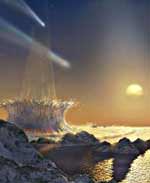
Image credit: David A. Hardy
Astronomers studying the Tau Ceti system have discovered that it contains ten times as much material in the form of asteroids and comets as our own solar system.
Tau Ceti, only 12 light years away, is the nearest sun-like star and is easily visible without a telescope. It is the first star to be found to have a disk of dust and comets around it similar in size and shape to the disk of comets and asteroids that orbits the Sun.
The astronomers’ discovery, being published in Monthly Notices of the Royal Astronomical Society, suggests that even though Tau Ceti is the nearest Sun-like star, any planets that may orbit it would not support life as we know it due to the inevitable large number of devastating collisions. It also suggests that the tranquil space environment around the Earth may be more unusual than previously realized.
Though the star Tau Ceti is similar to the Sun, any planets it has are unlikely to be havens for life, say a team of UK astronomers. Using submillimeter images of the disk of material surrounding Tau Ceti, they found that it must contain more than ten times as many comets and asteroids than there are in the Solar System.
With so many more space rocks hurtling around the star, devastating collisions of the sort that could lead to the destruction of life would be much more likely in the Tau Ceti system than in our own planetary system.
Publication of the result in Monthly Notices of the Royal Astronomical Society coincides with an exhibit ‘Hunting for Planets in Stardust’ at the Royal Society Summer Exhibition by the same science team from the UK Astronomy Technology Centre in Edinburgh and the University of St. Andrews.
The similarity between Tau Ceti and our own sun ends with their comparable sizes and luminosities, explains Jane Greaves, Royal Astronomical Society Norman Lockyer Fellow and lead scientist: ‘Tau Ceti has more than ten times the number of comets and asteroids that there are in our Solar System. We don’t yet know whether there are any planets orbiting Tau Ceti, but if there are, it is likely that they will experience constant bombardment from asteroids of the kind that is believed to have wiped out the dinosaurs. It is likely that with so many large impacts life would not have the opportunity to evolve.’
The discovery means that scientists are going to have to rethink where they look for civilizations outside our Solar System.
Jane Greaves continues, ‘We will have to look for stars which are even more like the Sun, in other words, ones which have only a small number of comets and asteroids. It may be that hostile systems like Tau Ceti are just as common as suitable ones like the Sun.’
The reason for the larger number of comets is not fully understood explains Mark Wyatt, another member of the team: ‘It could be that the Sun passed relatively close to another star at some point in its history and that the close encounter stripped most of the comets and asteroids from around the Sun.’
The new results are based on observations taken with the world’s most sensitive submillimetre camera, SCUBA. The camera, built by the Royal Observatory, Edinburgh, is operated on the James Clerk Maxwell Telescope in Hawaii. The SCUBA image shows a disk of very cold dust (-210 degrees C) in orbit around the star. The dust is produced by collisions between larger comets and asteroids that break them down into smaller and smaller pieces.
Original Source: NASA Astrobiology Story

The multitude of comets and asteroids orbiting Tau Ceti may be due to the lack of any Jupiter size or larger jovian planets. It’s my understanding of current thought on the subject that large, gaseous planets act as a broom that sweeps smaller bodies out of the system.
Surely, if there were any Jupiter sized bodies around TC, we would be identifying them at only 12 lightyears away!
I would like to know who discovered this star and when it was discovered.